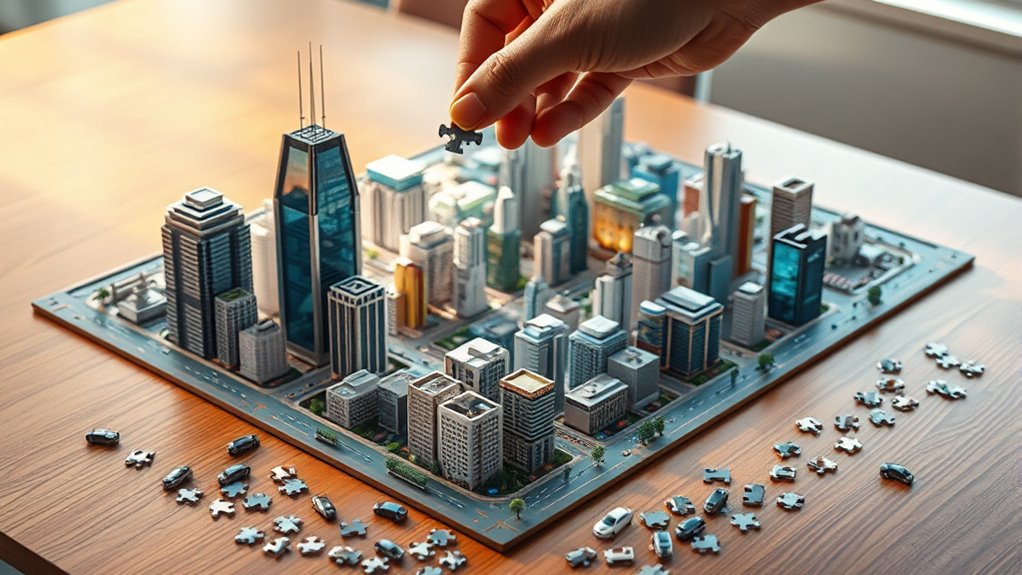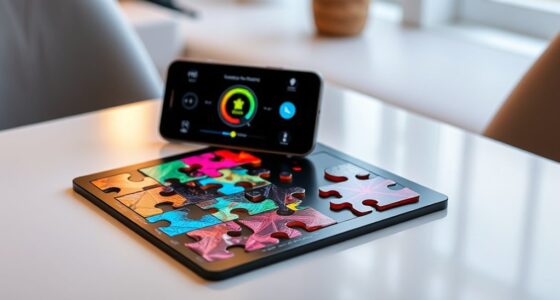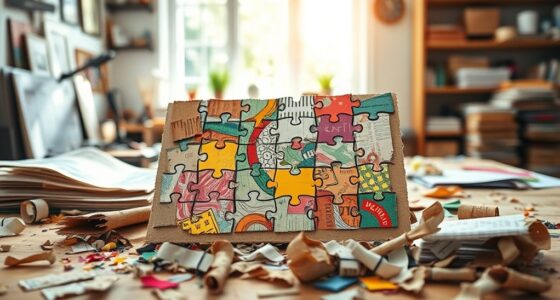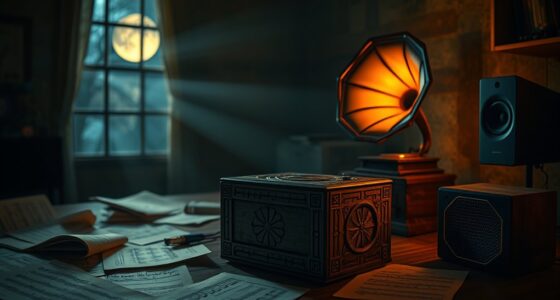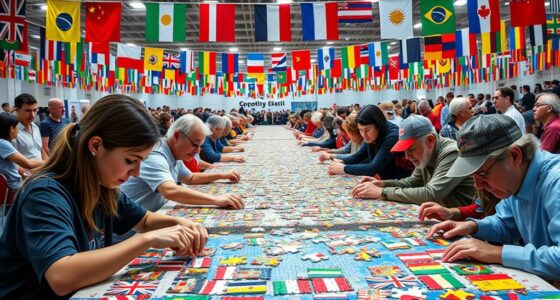To build your own 3D city puzzle successfully, start by organizing pieces through sorting by color, size, or section. Keep your workspace tidy to handle pieces easily. Use urban design principles like placing taller buildings near hubs and smaller homes in neighborhoods for realism. Pay attention to details like parks and bridges for vibrancy. Practice patience and experiment with layouts to improve. Continue exploring these techniques for a more detailed, cohesive cityscape.
Key Takeaways
- Organize puzzle pieces by color, size, or city section to streamline assembly and reduce confusion.
- Incorporate urban design principles by placing taller buildings near open spaces or transportation hubs for realism.
- Focus on connection points and edges for precise fitting, ensuring a stable and cohesive cityscape.
- Add details like parks, bridges, and public squares to enhance the vibrancy and authenticity of your city model.
- Practice patience and iterative rearrangement, reflecting on urban layout to improve overall appearance and functionality.
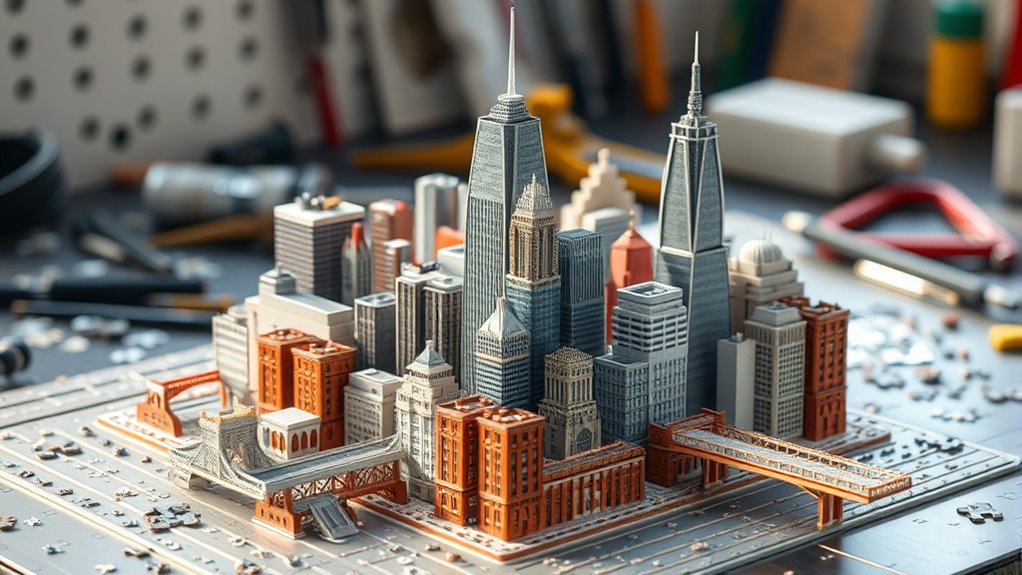
Creating a 3D city puzzle is a rewarding project that challenges your spatial skills and creativity. When beginning this task, you’ll find that understanding the principles of urban design can greatly enhance your puzzle assembly process. Urban design involves planning the layout and organization of city elements, which helps you visualize how different structures fit together in three dimensions. As you start, pay close attention to the instructions and the diagrams included, as they often incorporate key urban design concepts that guide you through the correct placement of buildings and infrastructure. This awareness guarantees your finished model reflects not just a collection of pieces, but a coherent, realistic cityscape.
During puzzle assembly, it’s essential to sort pieces methodically. Separate them by color, size, or section to streamline the process. This approach minimizes frustration and saves time, allowing you to focus on the larger task of building your city. As you begin fitting pieces together, check the edges and connection points carefully. Many 3D puzzles feature interlocking parts that require precise alignment. Patience is key here; rushing can lead to misaligned segments, which might be difficult to correct later. Keep your workspace organized, with plenty of room to maneuver, so you can comfortably handle the pieces as your city begins to take shape.
While assembling, consider the urban design aspect—think about how buildings relate to each other spatially. For example, taller structures might be placed near open plazas or transportation hubs, creating a realistic city skyline. Smaller buildings can fill in residential neighborhoods or commercial districts. This mindset turns your puzzle assembly into an imaginative exercise, where you’re designing a miniature city rather than just fitting pieces together. Don’t be afraid to experiment with different configurations; sometimes, a slight rearrangement results in a more balanced or visually appealing layout. This iterative process enhances both your problem-solving skills and your understanding of urban planning.
Finally, pay attention to the details that bring your city to life. Adding small elements like parks, bridges, or public squares can elevate your model from a simple structure to a vibrant urban environment. Incorporating a sense of scale and proportion helps your city look more realistic and cohesive. As you complete the puzzle, reflect on how urban design principles influence the overall aesthetics and functionality of your city. Building your own 3D city puzzle isn’t just about the satisfaction of completing a challenging project; it’s an engaging way to explore how cities are shaped and organized. With patience, careful puzzle assembly, and an eye for urban design, you’ll create a miniature metropolis that’s both impressive and insightful.
Frequently Asked Questions
What Materials Are Best for Durable 3D City Puzzles?
For durable 3D city puzzles, you should choose materials like high-quality cardboard, MDF, or plastic, as they offer excellent durability factors. Cardboard with thick layers resists wear and tear, while MDF provides sturdiness and a smooth finish. Plastic pieces are highly resistant to damage and moisture. Your material selection plays a vital role in ensuring your puzzle holds up over time, especially if you plan to display or handle it frequently.
How Can I Customize My City Layout Creatively?
Think of your city layout as a blank canvas waiting for your brushstrokes. To customize it creatively, blend your love for urban planning with artistic expression by designing unique building shapes, colorful streets, and themed districts. Mix modern and historic elements, add parks or landmarks, and play with scale. This approach makes your 3D city puzzle a vibrant reflection of your imagination, turning it into a one-of-a-kind masterpiece.
Are There Digital Tools to Assist in Designing Puzzles?
Yes, there are digital tools that can help you design puzzles. Virtual modeling and design software like SketchUp, Blender, or Tinkercad let you create detailed city layouts easily. You can experiment with different structures, customize features, and visualize your design before building. These tools make the process more precise and efficient, allowing you to bring your creative ideas to life with ease and confidence.
What Safety Precautions Should I Consider During Assembly?
When assembling your 3D city puzzle, you should prioritize safety by handling pieces carefully to avoid sharp edges. Always work in a well-lit area to see clearly and prevent accidents. Use glue safely by applying it in a well-ventilated space and avoiding skin contact. Keep tools out of reach of children, and wash your hands afterward. These precautions help guarantee a safe and enjoyable building experience.
How Do I Incorporate Lighting Into My 3D City Model?
Ever wondered how to make your city glow with realism? To incorporate lighting, you can add tiny LEDs inside buildings for lighting effects and use shadow techniques to create depth and contrast. Position lights strategically to highlight key features, and use dimmers for mood control. This approach transforms your 3D city model into an immersive, vibrant masterpiece that captures the essence of a bustling urban landscape.
Conclusion
As you bring your 3D city puzzle to life, remember that each piece is like a brick in your own skyline, shaping your masterpiece. With patience and creativity, you transform scattered parts into a vibrant metropolis—your personal cityscape. Keep building, imagining, and refining, because in this puzzle, every detail adds to the grand vista you’re creating. Soon, your completed city will stand tall, a proof to your skill and vision—truly a skyline born from your hands.
